Trigger Point Therapy - Treating Trapezius for Head, Neck and Shoulder Pain
Stuart Hinds: Treating trapezius trigger points with a Muscle Energy Technique (MET).
Just about everyone has trapezius trigger points. In most cases they can be treated simply and effectively for relieving head, neck and shoulder pain.
Treating trigger points in the upper trapezius can have a profound effect for many painful conditions.
In addition to compression techniques, we often use the following muscle energy techniques (MET's) to target the treatment areas (taught bands/trigger points).
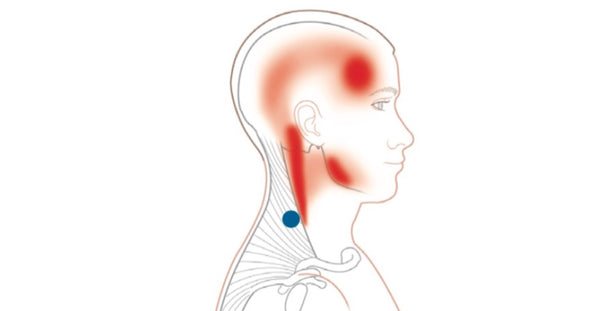
MET Treatment of Right Upper Trapezius
The therapist places the right upper trapezius in a position of bind, and asks the patient to either side bend the cervical spine to the right or elevate the right shoulder.
Alternatively, the patient may be requested to perform both of these actions at the same time against a resistance from the therapist.
Another way of communicating the technique is to ask the patient to bring the ear to the shoulder, or the shoulder to the ear, against a resistance, holding for 10 seconds.
After the 10-second contraction, the patient is asked to relax, take a breath in and on the relaxation phase the cervical spine is taken further into a left side bend.
If the side bending causes any discomfort, the shoulder can be taken into further depression, as this will also have the effect of lengthening the upper trapezius.
Reciprocal Inhibition (RI) Technique
If an RI technique is desired, the therapist takes complete control of the patient’s cervical spine and shoulder as described above.
From this position the patient is asked to reach slowly towards their lower right leg with their right hand, until a point of bind is felt.
This approach will activate the lower trapezius as the patient is causing a depression of the right shoulder girdle.
This will induce an inhibition of the right upper trapezius, allowing a safe way of lengthening as it will override the activation of the muscle spindles.
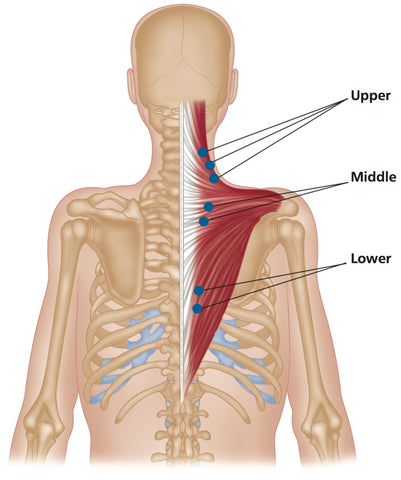
Trapezius - Common Trigger Point Sites
Targeting Specific Fibers
The upper trapezius has three fibre components: anterior, medial and posterior.
If you observe that certain fibers are tight, a simple rotation of the cervical spine will target specific fibers.
Figure (1) shows the patient’s cervical spine in a half rotation to the left; this targets the middle fibers of the upper trapezius.
If you were to take the cervical spine into full rotation, this would target the posterior fibers as seen in figure (2). No rotation of the cervical spine would target the anterior fibers.
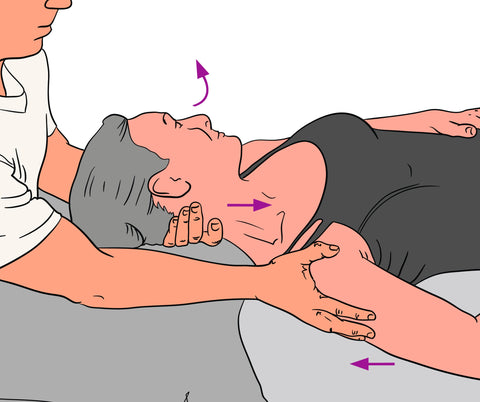
Figure (1) The patient is asked to side bend to the right or elevate the right shoulder, or both. Half rotation of the cervical spine emphasises the middle fibres of the trapezius.
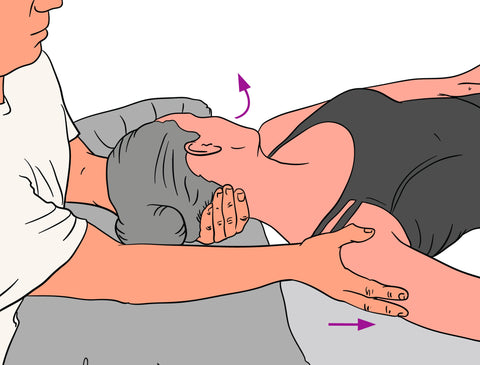
Figure (2) The therapist lengthens the right trapezius by applying caudal pressure. Full rotation of the cervical spine emphasises the posterior fibres.
An alternative hand position for the treatment of the upper trapezius is illustrated in figure (3) below.
As in figures (1) and (2), the therapist uses a cradle type of hold with their left hand; Figure (3) demonstrates a different hand contact with the therapist using their left hand.
Some clients find this position more comfortable.
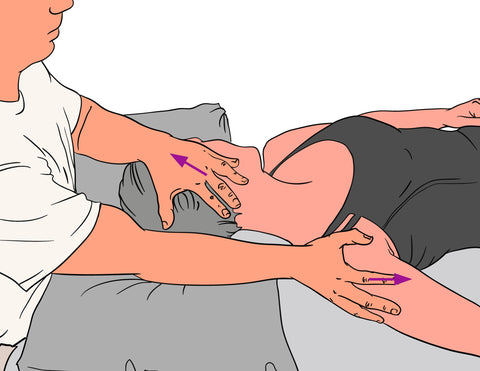
Figure (3) An alternative hand position for the treatment of the upper trapezius.
Links on This Site
More Articles About Trapezius Trigger Point Release
More Articles About Muscle Energy Techniques
Dry Needling for Trigger Points
Certify as a Trigger Point Therapist
NAT Education Membership Plans - from $19.95/monthly

NAT Online Course
Evaluating and Treating Neck Pain
See Details

NAT Education Membership Plans
Unlimited Access to All Online Courses
$19.95/monthly
This trigger point therapy blog is intended to be used for information purposes only and is not intended to be used for medical diagnosis or treatment or to substitute for a medical diagnosis and/or treatment rendered or prescribed by a physician or competent healthcare professional. This information is designed as educational material, but should not be taken as a recommendation for treatment of any particular person or patient. Always consult your physician if you think you need treatment or if you feel unwell.
About Niel Asher Education
Niel Asher Education (NAT Global Campus) is a globally recognised provider of high-quality professional learning for hands-on health and movement practitioners. Through an extensive catalogue of expert-led online courses, NAT delivers continuing education for massage therapists, supporting both newly qualified and highly experienced professionals with practical, clinically relevant training designed for real-world practice.
Beyond massage therapy, Niel Asher Education offers comprehensive continuing education for physical therapists, continuing education for athletic trainers, continuing education for chiropractors, and continuing education for rehabilitation professionals working across a wide range of clinical, sports, and wellness environments. Courses span manual therapy, movement, rehabilitation, pain management, integrative therapies, and practitioner self-care, with content presented by respected educators and clinicians from around the world.
Known for its high production values and practitioner-focused approach, Niel Asher Education emphasises clarity, practical application, and professional integrity. Its online learning model allows practitioners to study at their own pace while earning recognised certificates and maintaining ongoing professional development requirements, making continuing education accessible regardless of location or schedule.
Through partnerships with leading educational platforms and organisations worldwide, Niel Asher Education continues to expand access to trusted, high-quality continuing education for massage therapists, continuing education for physical therapists, continuing education for athletic trainers, continuing education for chiropractors, and continuing education for rehabilitation professionals, supporting lifelong learning and professional excellence across the global therapy community.

Continuing Professional Education
Looking for Massage Therapy CEUs, PT and ATC continuing education, chiropractic CE, or advanced manual therapy training? Explore our evidence-based online courses designed for hands-on professionals.



















